Compiler: Liu Weihan
BY DIPL-ING. L. HEUSLER AND PROE DR.-ING. W.SCHNEIDER. VAW ALUMINIUM AG. BONN
In order to use thermal analysis to evaluate the modification treatment, it is necessary to understand the influence of alloying elements on the eutectic depression. This article aims to study the influence of magnesium on the modification of strontium, the influence of magnesium, silicon, copper and iron on the modification of sodium, and the results of thermal analysis. In addition, this study also conducted a rigorous inspection of the test methods provided by many commercial thermal analysis systems to determine the eutectic reference temperature. In most cases, this is done with the help of formulas available in the technical literature, which take into account the influence of alloying elements on the eutectic temperature.
Through observation, we found that the influence of magnesium is the most critical and the most uneven. For modifiers with a constant content, as the silicon content continues to increase, the sag value will decrease significantly. On the other hand, the sag value increases with the increase of copper and iron content. If the literature value is determined under different cooling conditions, it will lead to systematic errors in the thermal analysis system that uses the literature formula to determine the eutectic reference temperature of the unmodified melt. However, if the formula for alloy dependence is determined under machine-specific cooling conditions, there will be a high degree of agreement between the calculated reference temperature and the measured reference temperature. Determining the reference temperature of the ternary eutectic based on the cooling curve of the previously modified alloy (supposedly used by a system) is flawed because the magnesium content is not taken into account in the whole process.
introduction
Due to its good castability and good mechanical properties, aluminum-silicon alloy is the most commonly used casting alloy group. Their mechanical value can be further improved by the modification of sodium or strontium. This method has been used as early as the 1920s [1]. In this way, eutectic silicon exists in the form of fine dendrites, rather than in the granular or layered form obtained in alloys without additives. Especially in the absence of large flaky silicon particles, the elongation at break will be significantly improved. According to recent research on the modification mechanism, it is assumed that the growth of eutectic silicon crystals is hindered by strontium or sodium precipitation on the growth surface [2]. In turn, this leads to an increase in the formation of twin crystals, which is clearly reflected in two aspects: the significant dendritic shape of eutectic silicon; and the significant drop in eutectic temperature. This so-called depression (that is, the difference in eutectic temperature before and after modification) is usually used to evaluate and control modification, and is measured by thermal analysis.
By adding magnesium, copper or other alloying elements, the mechanical properties can be further improved. In addition to purely solid solution strengthening treatment for these elements, aging strengthening may be particularly important in these alloy systems. Therefore, adding 0.3% Mg* to AlSi7 alloy, and then performing a complete heat treatment process including solution heat treatment, quenching and artificial aging process, which can greatly improve the ultimate elongation and tensile strength, while maintaining a high elongation at break Long rate. The increase in strength is due to the precipitation of the sub-microscopic metastable magnesium-silicon phase in the artificial aging process, which happens to hinder the movement of the para-dislocations.
In aluminum-copper alloys, precipitation hardening is caused by the metastable aluminum-copper phase, and both types of precipitation exist in aluminum-silicon-copper-magnesium alloys, such as G-AISi9Cu3.
Recent studies [3] have shown that the presence of magnesium destroys the structure formation of modified aluminum-silicon castings. The image analysis method was used to quantitatively analyze the aluminum-silicon eutectic parameters such as the size and shape factor of silicon particles in the modified AlSi7 binary alloy. After the addition of magnesium, these parameters increased and were not uniform. The deterioration of the modified structure is due to the formation of Mg2SrAl4Si3 type intermetallic phase. On the other hand, in the unmodified aluminum-silicon alloy, even a magnesium content of about 1% has a slight refinement effect.
Due to the huge influence of modification on the structure and mechanical properties, it is necessary to ensure reliable control of the modification treatment before casting. The most accurate information is undoubtedly through metallographic inspection of sub-cast or complete specimens. However, this is very time consuming and is usually only feasible in offline situations, ie after casting. If possible, spectroscopic analysis can provide not only the content of alloying elements, but also information about the effect on the alloy under given cooling conditions. Therefore, thermal analysis has become more widespread in foundries as a method of evaluating modification. It is based on the fact that the addition of elements such as sodium or strontium can lower the eutectic temperature. This so-called depression can be used to measure the degree of modification and is closely related to the quantitative measurement of the aluminum-silicon eutectic structure parameters [4]. However, there are two problems with thermal analysis. The results are affected by experimental parameters such as cooling rate, melt and crucible temperature, alloying and auxiliary elements present in the melt. The analysis shows that when the cooling conditions during thermal analysis are similar to the actual casting cooling conditions, the degree of modification can be predicted most accurately [5]. In the presence of magnesium, A.Joenoes and E.Gruzleski [3] analyzed the influence of alloys and auxiliary elements on the depression. The results show that, as shown in Figure 1, as the magnesium content increases, the dent value continues to decrease, and subsequently the crystal grains of the eutectic Al-Si structure become coarser. Another problem is the need to know the eutectic temperature in the unmodified state to determine the pits. Thermal analysis of unmodified melts requires additional time. In addition, if the alloy manufacturer has added modifiers, this analysis is often impossible. Commercial thermal analysis systems deal with this problem in two ways. In order to be able to calculate the depression, most systems require a reference temperature, that is, the eutectic temperature entered in the unmodified state. This can be approximated by formulas that consider the effects of individual alloying elements [6, 7]. Part of the formula has been integrated in the software used in the analysis system, which means that only the content of alloys and auxiliary elements need to be entered. Another theoretical possibility is to analyze the cooling curve of the modified variant before the influence of alloying elements [8].
For each alloy element, the strength of the ternary eutectic reaction occurring at different temperatures can give information about the alloy content, and this information can be used to calculate the reference temperature.
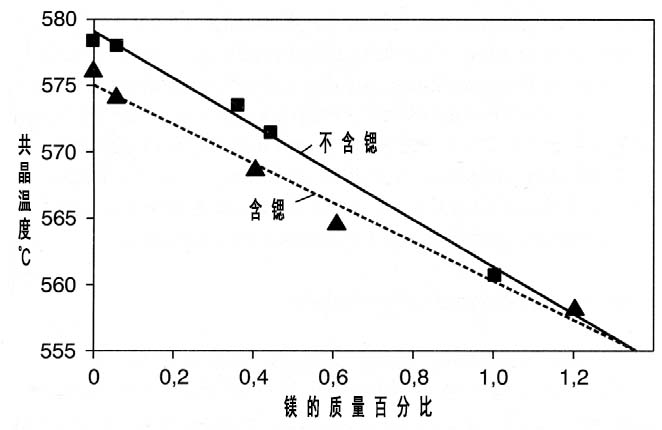
图1未改性和锶改性铝硅合金中共晶温度凹陷与镁含量的关系[3]
Therefore, in the practical application of thermal analysis, we need to know the exact effect of each alloying element on the eutectic temperature in the unmodified state. Their influence on the eutectic temperature depression is also crucial for effective and reliable evaluation of modification. Therefore, this study uses a large number of commercial thermal analysis systems to systematically analyze the effects of alloying elements silicon, magnesium, copper and iron on the eutectic temperature and sag. In addition, this article also strictly examines how these systems consider the effects of alloying elements. Furthermore, metallographic inspections will be performed on each test series, so that in each case the results of the thermal analysis will be closely related to the casting structure.
carry out testing
Due to the different effectiveness of the modified elements sodium and strontium, this study was conducted in two parts.
The alloy AlSi11 was used to check the strontium modification. First, record the strontium content and test parameters, such as melt temperature, crucible type and temperature influence on the analysis results. Then, the unmodified and strontium-modified alloy AlSi11 and AlSi11Mg containing 0.35% magnesium were tested to determine the effect of the alloying element magnesium. In order to determine the role of magnesium in more detail, AlSi11 alloys with a magnesium content of 0, 0.2, 0.35, 0.45, 0.6, and 1.0% were prepared and checked by thermal analysis in the unmodified and modified states.
For tests involving sodium modification, first use a binary aluminum-silicon alloy containing 5, 7, 9, 11, 13, and 18% silicon to determine the effect of silicon content on the thermal analysis results. The effect of magnesium was tested under the same conditions as the content of magnesium and strontium. In order to quantitatively study the influence of copper and iron on thermal analysis, the use of AlSi9 alloy can more easily transfer the results to the commonly used secondary alloy AlSi9Cu3. The copper content is divided into 0.1, 0.5, 1.2, 2.0, 2.8 and 3.5%. To test the effect of iron, the iron content was set to 0, 0.3, 0.5, 0.75, and 1.0%.
The alloy required for the experiment was synthesized from 99.7% primary aluminum, 99.999% pure magnesium and 99.9% pure silicon. Pure copper (99.99%) is added, and iron is added in the form of AlFe9 master alloy. Strontium is added in the form of 10% master alloy wire. For sodium modification, pure sodium is stirred into the melt wrapped in aluminum foil.
All alloy variants are melted in a resistance heating crucible furnace with a capacity of 60 kg. Initially, the temperature was set to 800°C to melt pure silicon. If other alloying elements are added, the temperature is then reduced to a casting temperature of 730°C. After spectroscopic verification of the desired composition, the unmodified and modified state is checked by thermal analysis.
Three commercial systems from different manufacturers are used. Unit A is used with permanent ceramic crucibles, unit B is used with steel crucibles or shell mold crucibles, and unit C is used with steel crucibles provided by the manufacturer. All these units are running at the same time, and the temperature distribution graph is recorded with the measuring system at the same time. In order to test the effect of higher cooling rate, we also cast a small chilled cast sample with a mass of 100g. The measurement system is still used to record their temperature profiles. Cast three samples for each test variant of each unit or mold, and record the cooling curve. In order to compare the results of the thermal analysis with the obtained microstructures, some selected samples were used to prepare metallographic specimens and inspected under an optical microscope.
Results and analysis
Influence of test parameters
Eutectic temperature. As shown in Figure 2, in the experiment, the melting temperature ranges from 750°C to 900°C, and the crucible and mold temperatures range from room temperature to 350°C. This shows that these two parameters affect the measured eutectic temperature. Not big picture 2. On the other hand, the influence of the crucible material is more significant. In ceramic and steel molds, the highest eutectic temperature, which is relatively close to the theoretical eutectic temperature of 577.5°C, is measured. The eutectic temperature measured in the shell crucible is about 1k lower, which may be caused by system measurement errors. The difference in the eutectic temperature measured in the steel mold for refrigeration hardening is particularly significant (low 4k). Obviously, due to the higher cooling rate, compared with the equilibrium reaction, the eutectic reaction will occur under a high degree of supercooling, which will result in a lower eutectic temperature.
Sunken. As shown in Figure 3, the influence of the mold material on the cooling rate is also reflected in the depression data, and these data are measured in a series of experiments with increasing strontium content. As originally expected, the sag value increased from the initial 0K (no strontium) to 4K (100 ppm strontium). For the alloy AlSi11 examined, this is clearly the maximum value, because no further increase in this value was observed, and in some cases, the sag value even dropped slightly. The higher cooling rate will increase the depression caused by the modification, which is especially obvious in the case of using steel refrigeration hard casting molds. Among them, in the strontium modification, the dent value is as high as 10K. Before the addition of strontium, the structure obtained from the mold for cold hardening even showed partially modified characteristics. This confirms the findings of many other studies, that is, the effect of higher cooling rate on the structure is similar to the modification treatment. Therefore, in order to evaluate the effect of the modification on the expected structure, thermal analysis should be performed under ideal conditions similar to actual casting. For the sake of simplicity, only the results obtained with permanent ceramic molds are discussed in detail below.

Figure 2 The relationship between the eutectic temperature of AlSi11 alloy and crucible material, melting and mold temperature
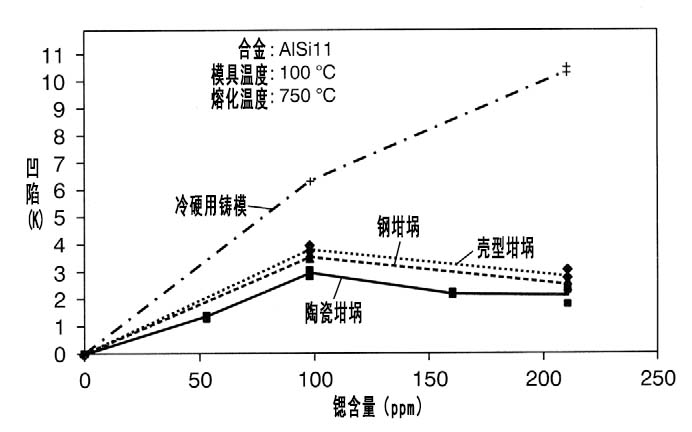
Figure 3 The relationship between AlSi11 alloy depression degree and strontium content and mold material
Influence of magnesium content
Strontium modification.After adding 0.35% of magnesium to the alloy AlSi11, the strontium content was continuously increased, and the above experiment was repeated under the same conditions. As shown in Figure 4, the results show that in the presence of magnesium, the sag value has reached 4K at a strontium content of 50ppm, and reached a maximum of 7-8K at a strontium content of 100-150ppm. Therefore, with the addition of 0.35% magnesium, the dent data can be increased from 4k to 7K at the maximum. This should be taken into consideration when using thermal analysis to evaluate modification. In most cases, the magnesium-free variant modified with a strontium content of 100 ppm and a 4K dent value (see Figure 5a) has a better modified structure than the magnesium-containing variant modified with a dent value of 7K (see Figure 5b).
In another set of experiments with alloy AlSi11, the obvious and strong influence of magnesium was examined more carefully, in which the magnesium content was systematically changed between 0 and 1%. As originally expected, the eutectic temperature decreases as the magnesium content increases, as shown in Figure 6. When the magnesium content is 1%, it is close to 11K. According to the definition, the eutectic temperature determined by the magnesium content is the reference temperature for determining the depression according to the eutectic temperature of the modified variant. Even taking into account this dependence, the magnesium content has a significant effect on the sag value obtained, as shown in Figure 7. In the alloy modified with 100ppm strontium, the increase from 3.5K without magnesium to 6K when the magnesium content is 0.35%-0.45%, and again drops to 3K when the magnesium content is 1%.

Figure 4 The relationship between eutectic depression and strontium content in AlSi11 and AlSi11Mg alloys
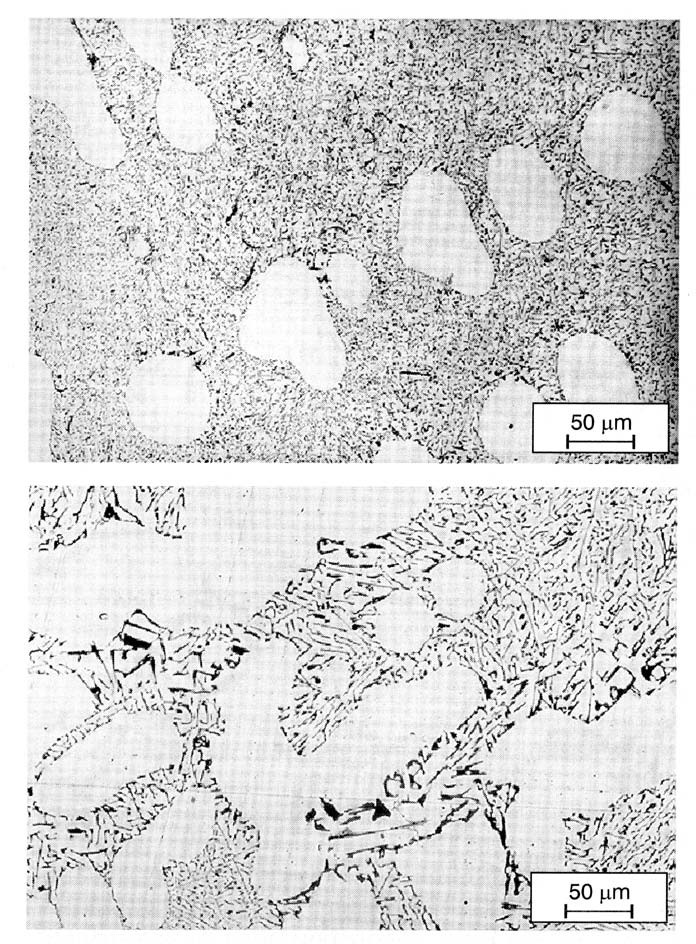
Figure 5 The microstructure of the alloy AlSi11 thermal analysis sample: a) No magnesium, with a depression value of 4K; b) Containing 0.35% magnesium, with a depression value of 7K
Even when the strontium content is 200 ppm, the curve has not changed significantly. This shows that under the current cooling conditions, a strontium content of 100 ppm can achieve the greatest degree of modification. When the strontium content is 50ppm, the sag value will decrease again, indicating that the modification process is insufficient. However, even in this case, a sag value of 5K can still be obtained with a magnesium content of 0.45%, which indicates that it is difficult to evaluate the modification using the sag produced with the change of the magnesium content. Comparing the photomicrographs, it can be seen to what extent the calculated depression value reflects the actual modification behavior. When the magnesium content is 0.1%, the structure in the unmodified state is relatively rough and flakes, as shown in Figure 8a. Add 200pm strontium for modification, see Figure 8b. On the one hand, in the unmodified state, a granular AlSi eutectic alloy with a magnesium content of 0.45% will be produced, as shown in Figure 8c. When the effect of the modification is significantly worsened, a scattered sheet structure will be formed, as shown in Figure 8d. On the other hand, thermal analysis is used to obtain the highest dent data in this state, and in this case it does not match the corresponding degree of modification. When 1.0% magnesium is added, the AlSi eutectic alloy structure of the unmodified and modified variants is approximately the same as the basic granular structure, and even when strontium is contained, they only appear in the independent modified area, as shown in Figure 8e and And 8f.

Figure 6 The relationship between the eutectic temperature of AlSi11 alloy and the magnesium content
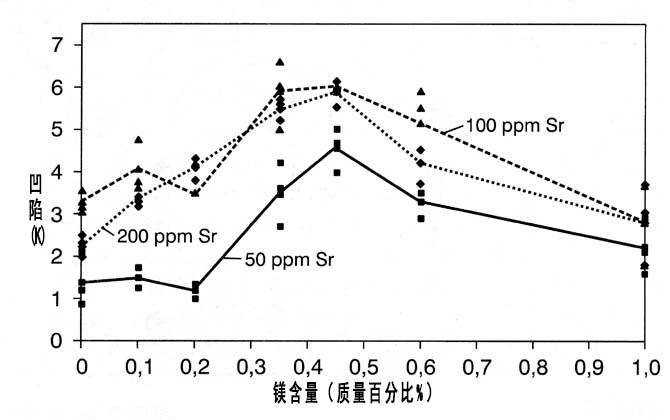
Figure 7 The relationship between eutectic depression and magnesium content (alloy AlSi11, strontium modification)
When the cooling rate is slow, magnesium has a significant negative effect on the modification (not detected by thermal analysis), and a slight refinement effect is observed on the unmodified AlSi structure. Compared with chilled molds, this structural change at a lower cooling rate is not obvious. And in this case, magnesium itself has a refinement effect, see Figures 9a and 9c. The modification effect after adding strontium is only slightly weakened by the addition of 1.0% magnesium, as shown in Figures 9b and 9d.
Sodium modification. In the case of sodium modification, magnesium and strontium have basically the same influence on the depression value. Nevertheless, there will still be some differences, see Figure 10.
When the sodium content is as low as 30 to 45 ppm (inadequate modification usually occurs), the dent value will increase from 0 K without magnesium to 6 K with a magnesium content of 0.45%, and then drop to about 5K. As the sodium content increases, the sag level continues to rise to a magnesium content of 0.35%, until it is approximately the same as the sag level obtained when the sodium content exceeds 0.45%. Only when the sodium content is 80 ppm, all the magnesium content is approximately 1K higher. These observations are consistent with the observations about the structure. However, when the sodium content of the magnesium-free alloy is as high as 70 ppm, the degree of modification is greatly improved. Although the modification is negatively affected to some extent, the AlSi eutectic is very similar when the magnesium content is 0.45%, and the sodium content can be ignored here.
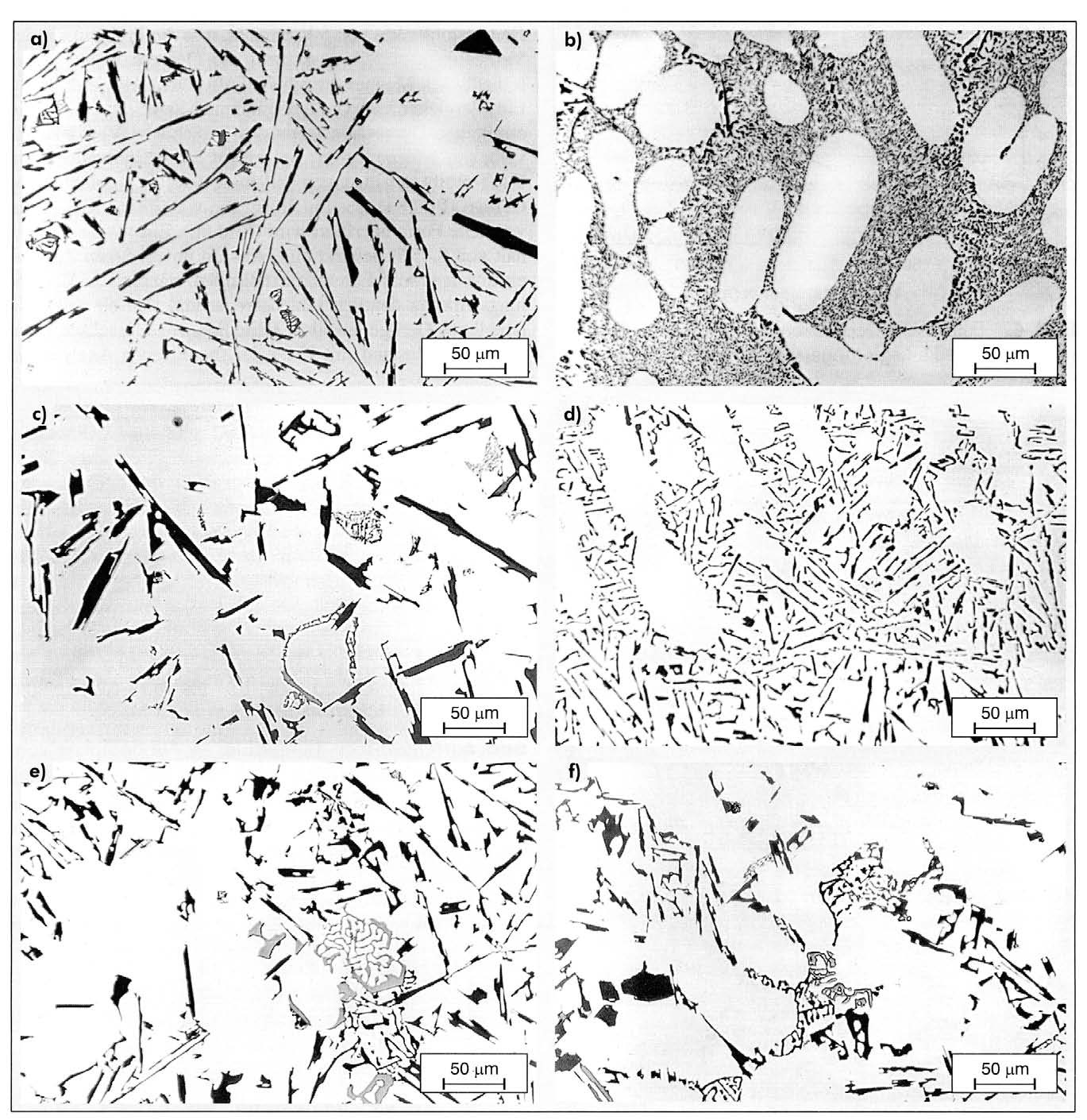
Figure 8 Comparison of unmodified and modified structures in thermal analysis samples with different magnesium contents: a) 0.1% Mg, without strontium; b) 0.1% Mg, 200 ppm strontium, with a depression value of 3.3 K; c) 0.45% Mg , Without strontium; d) 0.45% magnesium, 200 ppm strontium, dent value 5.9 K; e) 1.0% magnesium, no strontium; f) 1.0% magnesium, 200 ppm strontium, dent value 2.9 K.

Figure 9 Comparison of modified and unmodified structures in chilled cast samples with different magnesium content: a) 0.1% magnesium, without strontium; b) 0.1% magnesium, 200 ppm strontium; c) 1.0% magnesium, without strontium ; d) 1.0% magnesium, 200 ppm strontium
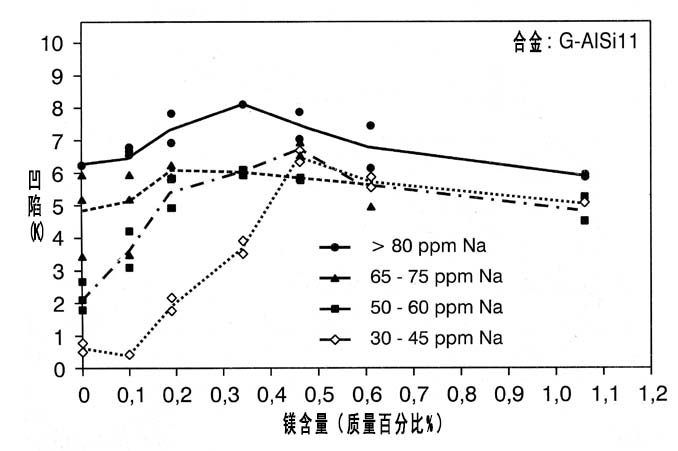
Figure 10. The relationship between eutectic depression and magnesium content (alloy AlSi11, sodium modification)
In addition to the increased depression value, the 80 ppm sodium content variant shows a more fully modified structure and contains unmodified areas.
Contrary to the observation result of strontium modification, as the magnesium content increases, the magnitude of change in the sag value is relatively lower in the fully modified (sodium content 65-75 ppm) and over-modified (sodium content 80 ppm) variants. But in the same way, as the magnesium content increases from 0 to 45%, the dent value increases from 5K to 6K and from 6K to 8K, accompanied by the deterioration of the modified structure. Therefore, when using thermal analysis to evaluate sodium modification, the influence of magnesium must be taken into consideration.
Influence of silicon content
It can be observed from the experiment that the silicon content has little effect on the eutectic temperature of the binary AlSi alloy, which is consistent with expectations. According to the corresponding cooling conditions of the crucible, the eutectic temperature range obtained in the detection range (silicon content of 5-18%) is 575 to 577°C, as shown in Figure 11. Taking into account the measurement error of the thermocouple, this conclusion can be regarded as a constant result. However, in the case of sodium modification, the relationship between the dent value and the silicon content is different. When the silicon content increased from 5% to 13%, we observed that if the sodium content increased from 65ppm to 90ppm, the sag value decreased from 9K to 5K, and if the sodium content was about 30ppm, it decreased from 2K to close to 0K. However, this rule has nothing to do with the structure, and when the sodium content is constant and the silicon content increases, no deterioration of the modification is observed. Therefore, in order to determine the critical value at which sufficient modification can occur, the silicon content must also be taken into account.

Figure 11. Eutectic temperature of AlSi alloys with different silicon content
Influence of copper content
Adding copper to the AlSi alloy will cause the eutectic temperature to drop. For the detection range of the base alloy AlSi9, we observed that the eutectic temperature dropped from 576.5°C (without copper) to 568.5°C (copper content 3.5%), which is consistent with various formulas in scientific literature (Figure 13). The effect of copper on the modification value is determined by the level of sodium (Figure 14). Although no effect was observed when copper was added to low sodium content (25-35ppm), as the copper content increased, the sink value for higher sodium content increased significantly. The increase is most pronounced when the variant contains about 45 ppm sodium. In the absence of copper, the dent value measured at this time is 2K, and when the copper content is 3.5%, the measured value is 8K. But on the other hand, if the sodium content is higher, the sink value only increases by 2K. Figure 15 shows the different structures formed by approximately 55 ppm sodium and different copper contents. However, with 0.1% copper added, the structure is completely modified (Figure 15a), but when the copper content is 1.2%, joints will appear between the eutectic clusters, and a copper-containing phase will appear at this time, and the AlSi eutectic will be rougher , As shown in Figure 15b. This effect is even more pronounced when the copper content is 3.5%, as shown in Figure 15c. The region containing rough eutectic silicon has very obvious characteristics of an over-modified structure. The characteristic that copper tends to be over-modified is also reflected in a significant increase in the sag value. Copper hinders the formation of a fully modified AlSi eutectic, but it is obviously not as strong as magnesium. In any case, the influence of copper on the eutectic depression must be taken into account when testing through thermal analysis.
Effect of iron content
According to scientific literature, every 1% iron will reduce the eutectic temperature by about 2K, which is relatively small compared with the influence of magnesium and copper. However, the test measured that the iron content will continue to decrease by 1-1.5K, but this is actually impossible to explain the phenomenon in Figure 16. When the iron content is between 0-0.4%, the deviation from the literature data is the largest, and the reading range is relatively wide at this time.
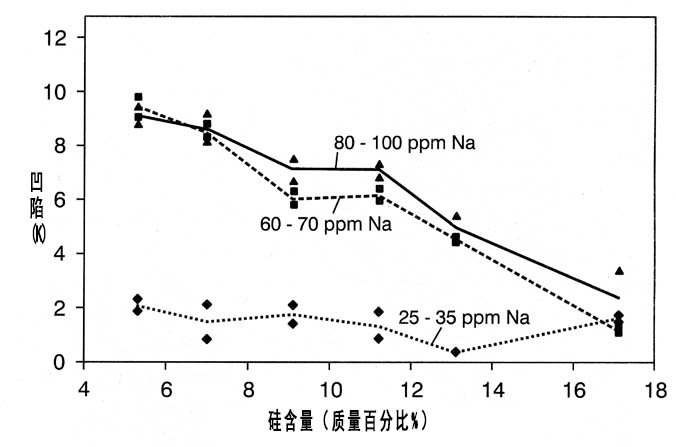
Figure 12. Eutectic recesses of AlSi alloys with different silicon content
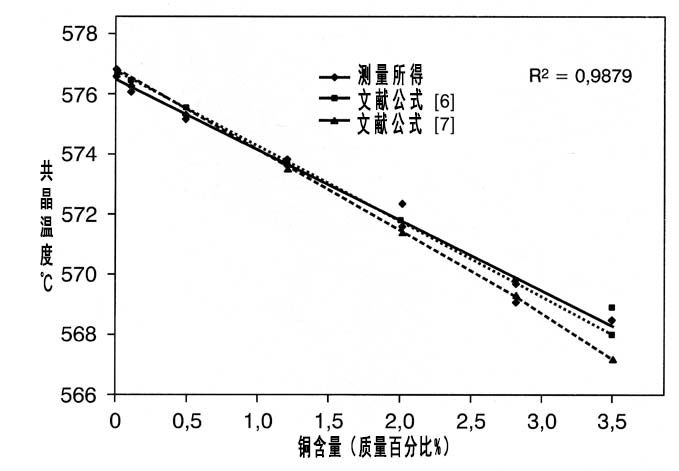
Figure 13. Eutectic temperature change of AlSi9 alloy with different copper content
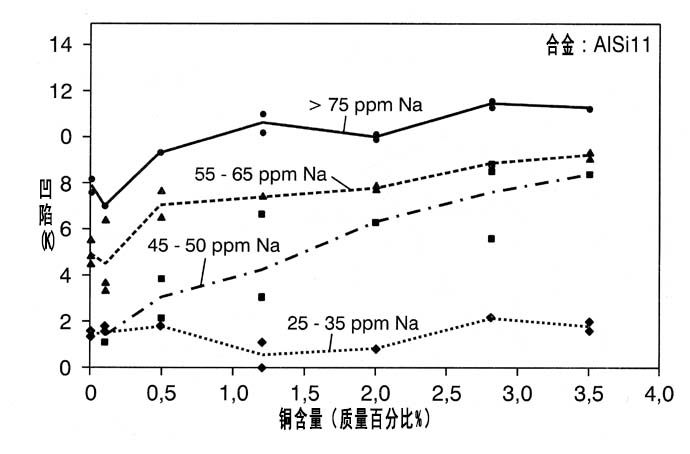
Figure 14. Eutectic depression of sodium modified alloy AlSi9 with different copper content
Even after modification with sodium, as the iron content increases, the sag value only increases by 2K at most (Figure 17). When the iron and sodium contents are 1.0% and 50 ppm, respectively, the structure is still fully modified. But as expected, there will be more β-Al5FeSi in the form of layered precipitates. In addition, when iron and copper appear at the same time (as is often the case in practice), their influence on thermal analysis is superimposed, so both elements can be considered separately.
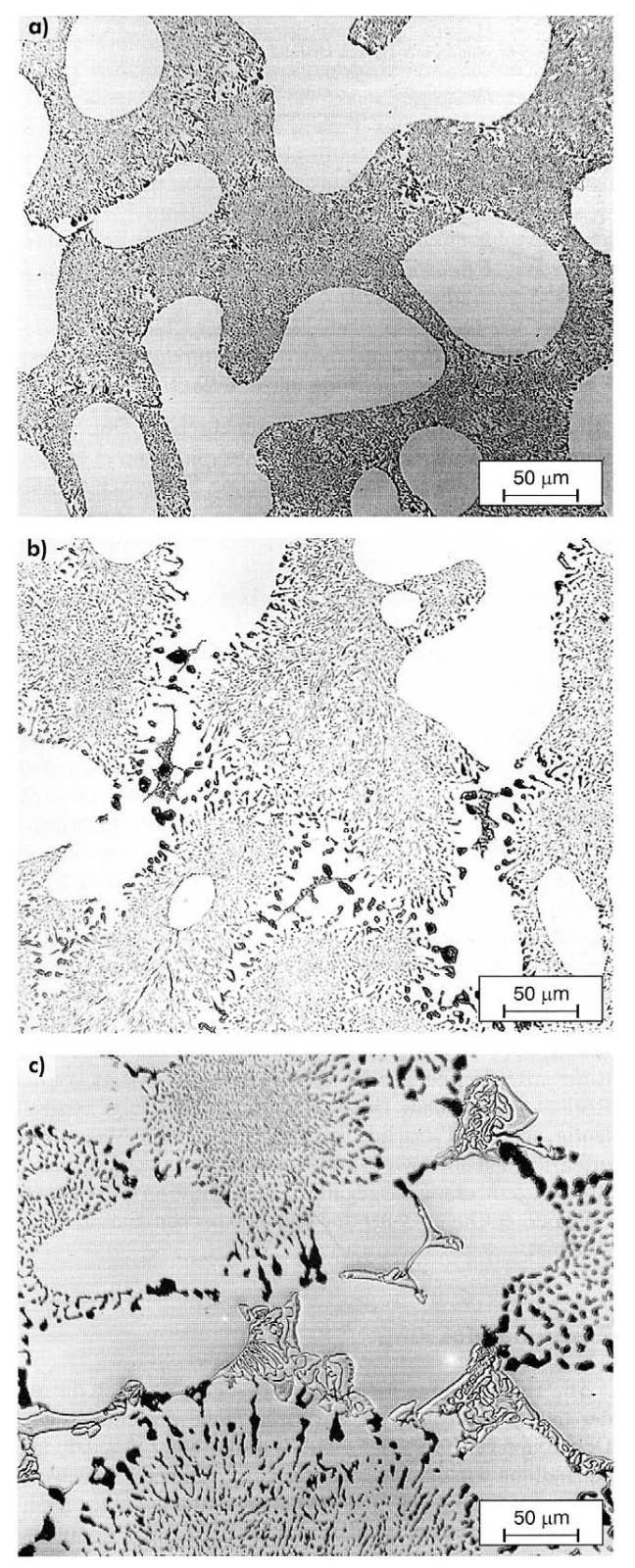
Figure 15. Comparison of modified structure (55-65ppm sodium) in AlSi9 alloy: a) 0.1% copper, recessed 3.8K; b) 1.2% copper, recessed 7K; c) 3.5% copper, recessed 9.5 K.
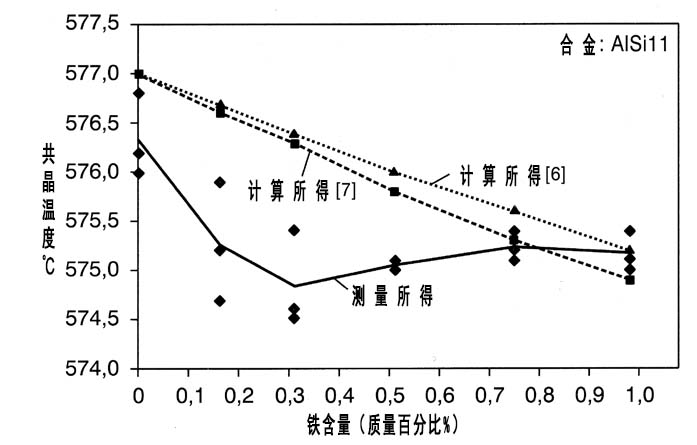
Figure 16. The relationship between eutectic temperature and iron content in AlSi9 alloy

Figure 17. Relationship between AlSi9 eutectic depression and iron content in sodium metamorphic alloy AlSi9
Results of using thermal analysis
The above discussion shows that the influence of various alloying elements must be considered when performing thermal analysis. For this reason, it is necessary to know the eutectic reference temperature of the unmodified alloy. In theory, there are four methods to determine their eutectic reference temperature:
• Separate measurement of reference temperature:
The most reliable method to determine this temperature is derived from the definition of "sag", which mainly lies in the thermal analysis of the unmodified alloy. However, this requires additional time and significantly extends the production time for each charge in the foundry. At the same time, many manufacturers have modified many alloys, which means that unmodified variants are usually not available.
• Reference temperature for formulas in scientific literature:
Some thermal analysis system manufacturers have embedded these formulas in the programs used by their equipment. Enter the content of important elements to calculate their influence on the reduction of the eutectic temperature. But in this way, you must first understand the chemical composition. In addition, it must be ensured that the formulas in the literature are determined under similar cooling conditions as the device described.
• System specific reference temperature:
In a given thermal analysis system, if the relationship between the eutectic temperature and the content of alloying elements has been calculated under the typical cooling conditions of the system, the uncertain factors in the use of literature formulas can be avoided.
But so far, no commercial equipment has put it into practice.
• The reference temperature of the cooling curve of the modified alloy in the past:
Theoretically, if the cooling curve of the previous modified alloy can be determined, there is no need to add important alloying elements. Manufacturers of thermal analysis systems often show that they have used this principle by determining the relative maximum temperature of the ternary AlSiMg and AlSiCu eutectic conversion, and inferring the magnesium and copper content from it.
The above four methods, namely:
•Measure the eutectic reference temperature in the unmodified alloy separately
•Calculate the reference temperature according to the formula in the scientific literature
• Use specific alloy formula to calculate system specific reference temperature
• Determine the impact on the alloy through the cooling curve of the unmodified alloy
Compare with each other in this study.
Figure 18 shows the magnesium content of the reference alloy AlSi11 and the eutectic temperature calculated using various methods. The curve calculated by the two literature formulas includes the actual curve (that is, the curve determined in the experiment using the ceramic crucible), and only deviates from about 4K, which may be due to the difference in cooling conditions. As originally expected, a higher cooling rate (such as the cooling rate in a steel mold for refrigeration hardening) will cause the curve to tilt toward lower temperatures. This device is used to determine the influence of magnesium on the cooling curve and calculate the constant eutectic temperature of each magnesium content setting value, that is, 1.0% magnesium, which is equivalent to the difference between the actual and calculated eutectic temperature as high as 10K.

Figure 18. The relationship between the magnesium content and the eutectic temperature measured in the steel crucible and the steel mold for refrigeration and hardening. Comparison of calculation methods in literature formula and cooling curve
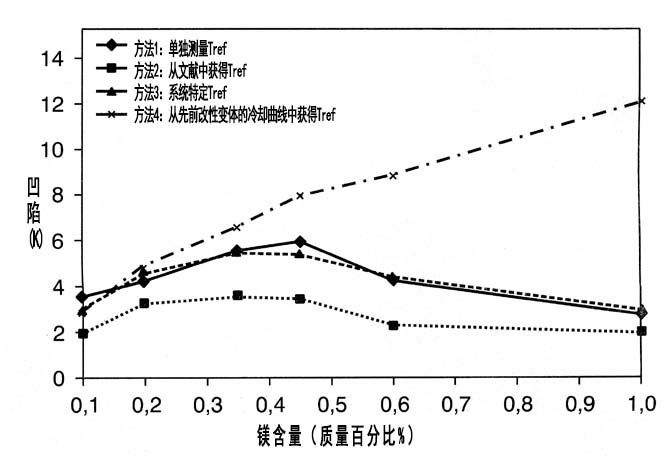
Figure 19. The relationship between the magnesium content (AlSi11, strontium modification) and the eutectic depression calculated by using different methods to determine the reference temperature (Tref=reference temperature).
Figure 19 shows the sag value calculated using the above method for the alloy AlSi11 modified with 200ppm strontium with reference to the magnesium content. The traditional method, that is, measuring the reference temperature of the unmodified variant, shows a relationship with the above-mentioned magnesium content. Due to the difference between the literature value and the actual value of the eutectic reference temperature, the sag value calculated by the literature formula is obviously different from the actual value. However, if literature values are not used, but the system-specific relationship between the eutectic temperature and the magnesium content specified in this study (that takes the actual cooling conditions in the test crucible into account) as the basis (Figure 6), the calculated depression The value is quite consistent with the actual value. In this case, adjust the formula according to the actual situation, even if the reference temperature is not measured, the depression can be accurately determined. This result was also observed in experiments using sodium modification. The fourth method (that is, calculating the influence on the eutectic reference temperature in the cooling curve) produces sag data that is significantly different from reality. This is obviously because the effect of magnesium is not measured at all, and a constant reference temperature is assumed. Although this method is simple and effective at first glance, it does not seem to be suitable for practical use.
to sum up
This study confirmed that the amount of eutectic recesses determined by thermal analysis can theoretically be used to evaluate and control the modification treatment. Test parameters such as melt and crucible temperature have only a slight influence on the depression value, but the influence of the test parameters of the alloying elements magnesium, copper and silicon is more significant, so it must be considered in the thermal analysis. As the silicon content increases, the eutectic depression decreases, and no negative effect on the modification is observed. With the increase of copper content, a significant increase in pits was observed, and the eutectic AlSi structure showed unmodified characteristics. Magnesium is the most critical factor for controlling modification by thermal analysis, because the eutectic depression depends largely on the content of magnesium and has nothing to do with the structure caused by the degree of modification. Only copper and iron are used to test the effects of multiple elements, and it is observed that the effects of these two elements can be superimposed.
The most reliable way to determine the eutectic reference temperature is to conduct thermal analysis on the unmodified melt. Only formulas for alloying elements determined under cooling conditions similar to current thermal analysis systems can be used to calculate the reference temperature. Calculating the content of alloying elements from the cooling curve proved to be unreliable and therefore not suitable for actual casting applications.
In summary, when evaluating the degree of modification through thermal analysis, it is necessary to set the sink value related to the existing cooling conditions of the alloy and the important parts of the casting. If there is no other method, these data can only be determined through a one-time test of the structure.
bibliography
[1] Pacz, A.: US-Patent, Nr.1, 387.990, 12.08.1921.
[2]Lu, S.; Hellawell, A.: Light Metals (1995) S.989-993.
[3]Joenoes, A.; Gruzleski, E.: Cast Metals 4 (1991) Nr.2, S.62-71.
[4]Heusler, L. u.a.: Giesserei-Praxis (1997) Nr.3/4, S.66-73.
[5]Chen, X.-G.: Kristallisation des AlSi-Eutektikums und Anwendung der thermischen Analyse zur Kontrolle der Veredelung. Dissertation. RWTH Aachen, 1991.
[6]Stuhldreier, G.; Stoffregen, K.W.: Giesserei 68 (1981) Nr.13, S.404-409
[7]Apelian, D.; Sigworth, G.K.; Whaler, K.R. (Mondolfo-Formel): Transactions of the American Foundrymen’s Society 92 (1984)
S. 297-307
[8]Dünkelmann, D.: Giesserei 82 (1995) Nr.18, S.678-681



